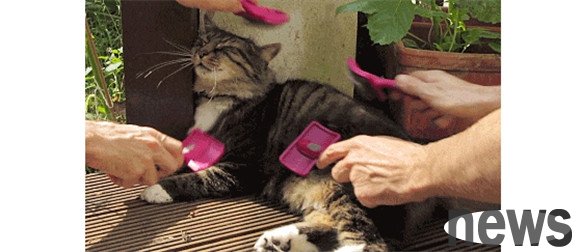Spring is a breeze for most people and a hundred flowers bloom, but for a few people it is a torture - repeated sneezing, runny nose and tears.
People are allergic to plant pollen, which is called "hay fever". Will cats also suffer from hay fever? Allergic reactions in cats:

allergic reactions are abnormal immune responses to harmless stimuli.
Cats generally do not have congenital allergies, but develop as they age. It is usually found between 6 months and 3 years old. Due to the difficulty of diagnosis, some cats are not diagnosed until they are 14 years old.
Common types can be divided into the following types:
-Food allergic reaction
-Atopic dermatitis
-Flea allergic dermatitis
-Asensitivity contact dermatitis
Pollen allergic dermatitis
Atopic dermatitis usually refers to an allergic reaction to environmental allergens such as pollen, mold, indoor dust mites, etc.
Among them, some allergies occur seasonally, such as allergies to pollen of cedar, cypress, and ragweed; some are non-seasonal, such as mold and dust mites.
The main symptoms are on the skin:
Cats with allergic conditions usually develop scab papules, also known as miliary dermatitis. You can feel many small and hard scab lesions on the skin when you feel.
Other symptoms include: itching, otitis externa, skin ulcers, pustules, messy and dull hair, and hair loss.
Atopic dermatitis can also cause sneezing, coughing, asthma-like respiratory problems and conjunctivitis.
How to diagnose and treat?
is mainly diagnosed through serological allergic tests and intradermal tests.
alleviation is caused by excessive responses to substances that are inherently not dangerous. Therefore, we need to calm our immunity:

1. Corticosteroids, antihistamines
In most cases, steroids will significantly reduce allergic reactions and quickly improve the clinical symptoms of the cat. They can be taken orally or injected, depending on the cat's condition.
Although cats have fewer side effects of long-term steroid use than dogs and humans, regular monitoring is still recommended.
Antihistamines may take 7-10 days to take effect, and some cats have poor responses to antihistamines.
In addition, supplementing essential fatty acids can enhance the skin barrier and reduce the inflammatory response, which is also a slow method of onset and may also help reduce the chance of recurrence.
2. Immunosuppressive drugs
such as cyclosporine, which target immune cells involved in atopic dermatitis to reduce immune responses, usually taking effect within one month.
3. Desensitization therapy
uses specific antigens or allergic vaccines to desensitize, and the body's response to such allergens is gradually reduced with long-term low-dose stimulation.
Atopic dermatitis is a lifelong disease and is common for frequent recurrences.
For most cats, the goal is to reduce the severity of itching and improve the quality of life, rather than eliminate it completely.
In daily life, the following methods can help reduce environmental allergens:
1. Do not let cats go out, especially in spring and autumn
2. Take off your coat, bag and hang the entrance hall immediately when entering the house, or use a hair sticker to roll from head to toe
3. Use an air purifier and place it in the entrance or corner best
4. Groom your cat every day